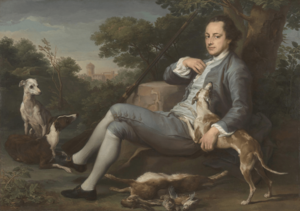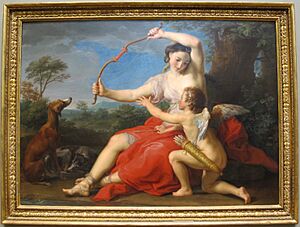Humphry Morice (MP for Launceston) facts for kids

Humphry Morice (born 1723 – died 18 October 1785) was a British politician. He was a member of the Whig political party. He served as a Member of Parliament (MP) for Launceston, a town in Cornwall, from 1750 until 1780.
Humphry Morice inherited a lot of money and land in 1750. This wealth also gave him control over who became Members of Parliament for two towns in Cornwall. Even though he was rich and powerful, he didn't reach the highest political positions, possibly because of his health. After 1760, he often traveled to Italy. There, he supported the famous painter Pompeo Batoni.
He held a government job called Comptroller of the Household for a short time in 1762. He later became Lord Warden of the Stannaries and joined the Privy Council, a group of important advisors to the King. However, he wasn't a very important political figure after that. His health got worse, and politics became very expensive. So, in 1775, he sold his political influence to the Duke of Northumberland. After 1782, he lived outside of England, and he passed away in Naples in 1785. He loved animals very much. In his will, he left a lot of money to make sure his horses and dogs were well cared for.
Contents
Early Life and Family Wealth
Humphry Morice was the first son of Humphry Morice, who was the Governor of the Bank of England. His mother was Catherine, his father's second wife. Humphry inherited his father's title in 1731. However, he didn't get much money from his father. This was because his father had faced serious financial problems for many years.
In 1750, young Humphry inherited a large amount of wealth. He also received the Werrington, Cornwall estate when his second cousin, Sir William Morice, 3rd Baronet, died. This estate gave Humphry control over choosing Members of Parliament for the towns of Newport and Launceston. Humphry himself became the MP for Launceston, taking his cousin's place after inheriting the estate.
Humphry Morice's Political Journey
Humphry Morice became an MP after inheriting his cousin's estate. He quickly showed his loyalty to the government. In 1754, he chose candidates who supported the government for the elections in Newport and Launceston. He kept one seat for himself. He hoped to be rewarded with a government job for his support.
In 1757, he was appointed as the second Clerk Comptroller of the Green Cloth. This was a job with a good salary. He was re-elected as MP for Launceston without any opposition.
Challenges and Travels
Having control over two parliamentary towns, Morice wanted to achieve higher political positions. However, this was difficult for him. He was known to be a bit sensitive, and his health was not always good.
Around 1760, he faced some legal troubles that affected his health. To recover, he traveled to Italy. This trip also allowed him to enjoy art and beauty. He visited Florence and Naples. In Rome, he had his portrait painted by the famous artist Pompeo Batoni. He became one of Batoni's most important English customers. He even bought Batoni's painting Diana and Cupid.
Morice loved collecting paintings, especially landscapes. He built a remarkable collection at his house, "The Grove," in Chiswick. He was also a keen sportsman and enjoyed foxhunting. He was especially kind to animals. In his portrait by Batoni, he is shown after a day of hunting, with three of his beloved dogs around him.
Government Roles and Later Years
While he was traveling, King George II died. When a new government was formed, Morice lost his job at the Board of Green Cloth. He felt this was unfair.
However, Morice later supported Lord Bute, who was gaining power under the new king. By chance, he was offered the important job of Comptroller of the Household at the end of 1762. He took the job and became a member of the Privy Council in January 1763. But the government changed again in April, and he lost this position.
To make up for it, he was appointed Lord Warden of the Stannaries in June. This job involved overseeing the tin mines in Cornwall. He continued to support the government, but he didn't give any speeches in Parliament and seemed to attend only sometimes.
Selling His Political Influence
Morice's political influence began to fade. In the 1774 election, he faced a tough challenge in Launceston. He won his own seat, but his chosen candidate for the other seat lost. This event made him decide to leave politics.
In early 1775, he sold his Werrington estate to the Duke of Northumberland. This sale was for a large sum of money, nearly £100,000. Morice explained that the cost of elections, his poor health (gout), and the challenges in the 1774 election convinced him to give up control of the towns.
Health and Lasting Legacy
Humphry Morice's health continued to decline. He suffered from gout, a painful joint condition. He spent time in Paris and Bath trying to find a cure. In 1781, he received good news: a widow named Margaret left him an estate that provided him with £1,500 per year for the rest of his life.
Morice wrote his will in July 1782, just before leaving England for the last time. He also resigned from his role as recorder of Launceston. He passed away on 18 October 1785, in Naples.
His will showed his unique character. He asked his surgeon to remove his heart after death to make sure he wasn't buried alive by mistake. He also made sure his servants in Naples could stay in his house for a while, so they wouldn't have to travel back to England during very hot or cold weather.
Most notably, an earlier part of his will showed his deep love for animals. He set aside £600 a year from his estates to pay for the care of his horses and dogs. Any money left over would go to his relative, Mrs. Levina Luther. His art collection was sold to the Earl of Ashburnham.


